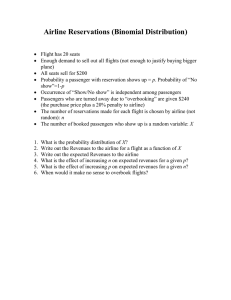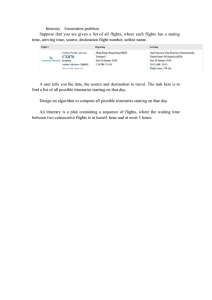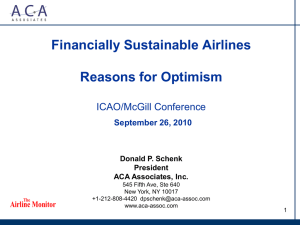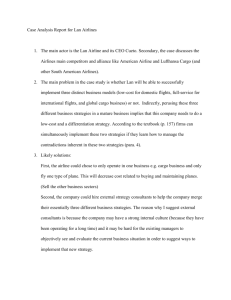sample CORE report.
advertisement
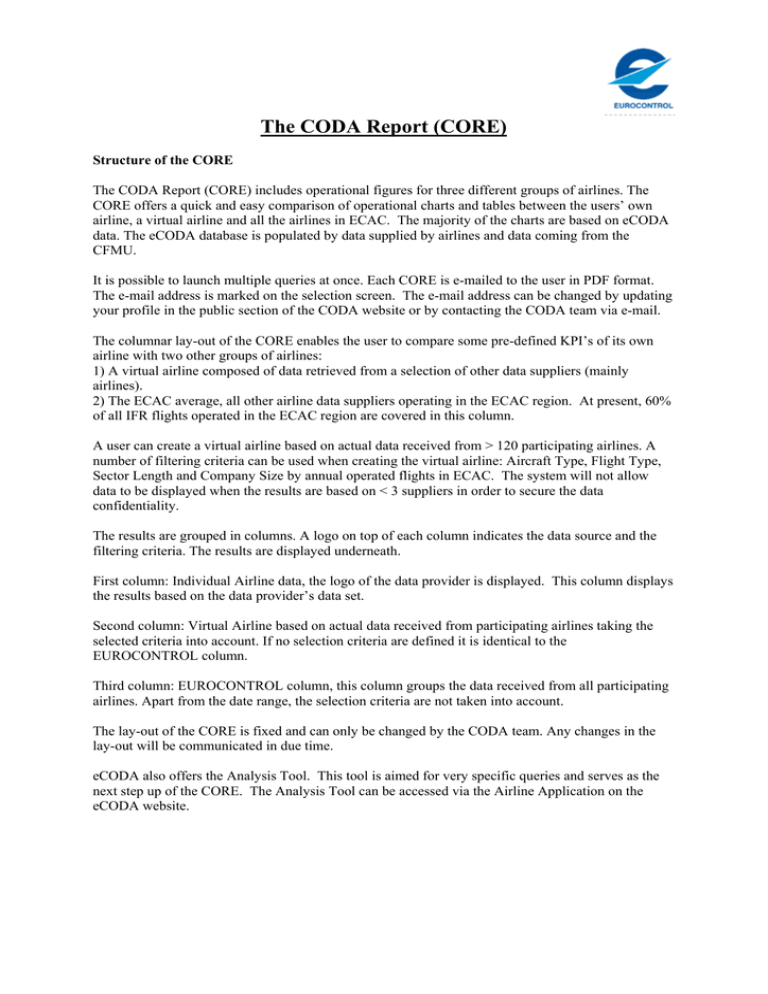
The CODA Report (CORE) Structure of the CORE The CODA Report (CORE) includes operational figures for three different groups of airlines. The CORE offers a quick and easy comparison of operational charts and tables between the users’ own airline, a virtual airline and all the airlines in ECAC. The majority of the charts are based on eCODA data. The eCODA database is populated by data supplied by airlines and data coming from the CFMU. It is possible to launch multiple queries at once. Each CORE is e-mailed to the user in PDF format. The e-mail address is marked on the selection screen. The e-mail address can be changed by updating your profile in the public section of the CODA website or by contacting the CODA team via e-mail. The columnar lay-out of the CORE enables the user to compare some pre-defined KPI’s of its own airline with two other groups of airlines: 1) A virtual airline composed of data retrieved from a selection of other data suppliers (mainly airlines). 2) The ECAC average, all other airline data suppliers operating in the ECAC region. At present, 60% of all IFR flights operated in the ECAC region are covered in this column. A user can create a virtual airline based on actual data received from > 120 participating airlines. A number of filtering criteria can be used when creating the virtual airline: Aircraft Type, Flight Type, Sector Length and Company Size by annual operated flights in ECAC. The system will not allow data to be displayed when the results are based on < 3 suppliers in order to secure the data confidentiality. The results are grouped in columns. A logo on top of each column indicates the data source and the filtering criteria. The results are displayed underneath. First column: Individual Airline data, the logo of the data provider is displayed. This column displays the results based on the data provider’s data set. Second column: Virtual Airline based on actual data received from participating airlines taking the selected criteria into account. If no selection criteria are defined it is identical to the EUROCONTROL column. Third column: EUROCONTROL column, this column groups the data received from all participating airlines. Apart from the date range, the selection criteria are not taken into account. The lay-out of the CORE is fixed and can only be changed by the CODA team. Any changes in the lay-out will be communicated in due time. eCODA also offers the Analysis Tool. This tool is aimed for very specific queries and serves as the next step up of the CORE. The Analysis Tool can be accessed via the Airline Application on the eCODA website. eCODA PDF report Dynamic CODA profile LOGO Eurocontrol The company logo of the data supplier is displayed on top of the first column. A logo indicating the Virtual Airline is displayed on top of the second column. The CODA logo is displayed on top of the third column indicating the ECAC region. The third column will give an overall picture of the ECAC region. For the third column, only the date range is taken into account. Filter Criteria This section indicates the filter criteria used per column. Following filters can be applied: Date Range, Aircraft Type, Flight Type, Sector Length and Airline Size (by number of annual flight in ECAC). The first and second columns are subject to these criteria, the third column is only subject to the date range. Period: from 12-04-2006 to 12-11-2006 A/C Type: All Flight Type: All Sector Length: > 1500 Annual Flights: BETWEEN 25000 AND 75000 Period: from 12-04-2006 to 12-11-2006 A/C Type: ALL Flight Type: ALL Sector Length: >0 Annual Flights: >0 eCODA coverage of IFR Flights This pie-chart displays the eCODA coverage of IFR flights using the above mentioned filtering criteria. The pie-chart should indicate 100% in the first column if an airline supplied data for all the IFR flights it operated in the ECAC region. The CODA target is 70% eCODA coverage of all IFR flights operated in ECAC. The present coverage is +- 60%. Data source: eCODA Total AO’s departures per time This line-chart indicates the number of operated flights by length of delay (all causes).The eCODA database is used as main data source. Data source: eCODA Overview Chart with actual data plotted This line-chart displays four values: Actual Departure & Arrival Delays and the Average Departure & Arrival Delay as reported to CODA by the airline. The Actual Departure & Arrival Delays are sorted from the smallest to the longest. Flights departing or arriving ahead of schedule are therefore plotted below the X-axis. Data source: eCODA 21 February 2007, 18:07 page 1 eCODA PDF report Punctuality/Delay Ratio on Flights This bar-chart displays the punctuality/delay ratio during each flight segment. Following formulae are used: Delay on Formula Departure : OUT - STD Taxy Out : OFF - (OUT + Std Taxy Out) CTOT vs ATOT :((COBT+Std Taxy Out)-5’/+10’)-ATOT Take-off : OFF - (STD + Std Taxy Out) En Route : ON - (OFF + EET) or ON - ETA Landing : ON - (STA - Std Taxy In) Taxy In : IN - (ON + Std Taxy In) Arrival : IN - STA Sched Pad : (IN - OUT) - (STA - STD) Primary Departure Delay Causes by total delayed flights > 1 min A pie-chart indicating the proportion of delayed flights by reason of delay, counting from one minute delay. This pie-chart is based on data supplied by the airlines and groups delay codes. An overview of the composition of each group can be found on the public part of the eCODA website. Data source: eCODA Total Generated Delay Minutes per category A pie-chart indicating the proportion of total delay minutes by reason of delay, counting from one minute delay. Data source: eCODA ATFM Delay comparison : Selected period vs previous period 21 February 2007, 18:07 page 2 eCODA PDF report Comparison of ATFM delays, as reported by the airlines, between the selected period and the previous period. An overview of the IATA delay codes used is listed on the bottom of the chart. Data source: eCODA ATFM CODA Indicators compared to same period last year Comparison of ATFM delays, as reported by the airlines, between the selected period and the same period one year earlier. An overview of the IATA delay codes used is listed on the bottom of the chart. Data source: eCODA Route Network based on length of flight Overview of the route structure based on the length of the flight as indicated in the filed flight plan. Data source: eCODA Total Flights(TTF) and Average ATFM Delay per Movement(ADM) split in Airport and En-Route by Flight Level Chart indicating the Total operated Flights (TTF) by flight level and the Average ATFM Delay per Movement (ADM) on these flights. The Average ATFM Delay per Movement is split in the airport and en-route part. Source: CFMU 21 February 2007, 18:07 page 3 eCODA PDF report Evolution of Average Delay per Movement This chart combines the ADM as reported by the airlines and the ADM reported by CFMU. It also indicates the ADM for all causes of delay. The ADM for all causes of delay is also taken from the eCODA database. Delays are only counted as from 5 minutes. Source: eCODA 21 February 2007, 18:07 page 4 eCODA PDF report Average Taxi-out Times sorted by difference with CFMU Taxi-Out Times. Station ICAO Provider Average Actual Taxi-Out Profile Average Actual Taxi-Out CFMU Taxi-Out CFMU vs Provider LGW EGKK 18 20 20 2 MAN EGCC 14 19 15 1 BUD LHBP 10 8 10 0 IST LTBA 15 13 15 0 FCO LIRF 20 19 20 0 ATH LGAV 13 12 12 -1 LCA LCLK 11 6 10 -1 LIS LPPT 13 12 12 -1 BHX EGBB 16 15 15 -1 LHR EGLL 23 29 20 -3 VIE LOWW 17 16 13 -4 CAI HECA 19 13 15 -4 WAW EPWA 14 17 10 -4 SKG LGTS 12 11 5 -7 LED ULLI 17 14 10 -7 KEF BIKF 17 10 10 -7 DME UUDD 17 12 10 -7 TLV LLBG 19 23 10 -9 The lay-out of the CORE changes, from here on the results are displayed in tables. This table is based on eCODA data and lists some of the airports served by the Airline. The Average Taxi-Out is calculated for the individual airline and the profile (or Virtual Airline). The CFMU Taxi-out is taken from the CFMU tables. The table is sorted by difference between the CFMU Taxi-Out and the average taxi-out for the individual airline. Source: eCODA 21 February 2007, 18:07 page 5 eCODA PDF report Average Taxi-in Times sorted by difference with ECAC Average Taxi-in Times Station ICAO Provider Average Actual Taxi-In Profile Average Actual Taxi-In ECAC Average Taxi-In previous Calendar Year ECAC Average vs Provider FCO LIRF 5 9 9 4 LAX KLAX 12 16 15 3 JFK KJFK 10 12 13 3 DFW KDFW 7 10 9 2 TLV LLBG 5 6 7 2 YUL CYUL 5 6 7 2 MIA KMIA 5 7 7 2 MAN EGCC 7 12 8 1 YYZ CYYZ 10 11 11 1 LCA LCLK 5 4 6 1 BOS KBOS 8 8 9 1 SKG LGTS 5 5 5 0 ATH LGAV 7 6 7 0 BUD LHBP 5 6 5 0 LGW EGKK 8 11 8 0 KEF BIKF 7 7 7 0 DME UUDD 8 6 8 0 MAD LEMD 9 7 8 -1 WAW EPWA 6 5 5 -1 LIS LPPT 6 5 5 -1 ORD KORD 11 9 9 -2 DXB OMDB 11 13 9 -2 LED ULLI 11 10 9 -2 CAI HECA 10 8 8 -2 LHR EGLL 12 9 8 -4 IST LTBA 10 6 6 -4 This table is based on eCODA data and lists some of the airports served by the Airline. The Average Taxi-In is calculated for the individual airline and the profile (or Virtual Airline). The ECAC Average displays the average Taxi-In of all airlines reporting to CODA during the previous year. No selection criteria are used to determine this figure. The table is sorted by difference between the Average Taxi-In of the ECAC and the Individual airline. Source: eCODA 21 February 2007, 18:07 page 6 eCODA PDF report Overview of average and percentile blocktimes compared to Scheduled Blocktime served by the AO. DEP ICAO ARR ICAO Provider Avg Scheduled Block Provider Avg Actual Block Profile Avg Scheduled Block Profile Avg Actual Block ECAC Avg Scheduled Block ECAC Avg Actual Block Percent Rank EGLL KJFK 07:39 08:11 07:50 08:20 07:44 08:15 0 EGLL KBOS 07:27 07:42 07:25 07:49 07:26 07:45 10 EGLL KMIA 09:45 09:59 09:45 10:16 09:45 10:05 21 EGLL KORD 08:48 08:56 08:44 08:50 08:46 08:53 48 EGLL KLAX 11:00 11:02 11:20 11:27 11:06 11:10 50 KLAX EGLL 10:13 10:16 10:20 10:19 10:15 10:17 50 EGKK KDFW 10:10 10:08 10:28 10:23 10:22 10:18 57 KJFK EGLL 06:49 06:51 07:01 06:57 06:54 06:54 57 KORD EGLL 07:41 07:36 07:35 07:22 07:37 07:28 65 KDFW EGKK 08:40 08:30 08:58 08:44 08:52 08:39 71 KMIA EGLL 08:18 07:59 08:29 07:50 08:22 07:56 79 KBOS EGLL 06:22 06:05 06:27 06:19 06:24 06:11 95 This table compares the average and actual blocktimes on city-pairs served by the airline. These figures are displayed for the individual airline, the profile (or virtual airline) and the ECAC average. The table is sorted by the % of flights where the actual blocktime was within the scheduled blocktime. The percent rank ranges from 0% to 100%. At 0% there were no flights with an actual blocktime shorter or equal to the scheduled blocktime. At 100%, all the actual blocktimes were always shorter than the scheduled blocktime. 21 February 2007, 18:07 page 7

